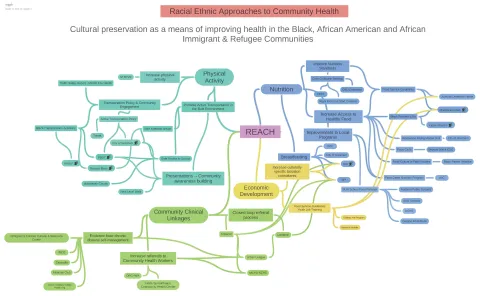At A Glance
Multnomah County Health Department’s Racial and Ethnic Approaches to Community Health (REACH) program collaborates with over 65 community-based partners to implement its three primary strategies, two cross-cutting strategies and many activities addressing chronic disease in the African American and African immigrant/refugee communities. Leveraging the Ripple Effect Mapping (REM) exercise annually, the REACH program and partners visualize the connections between their work in achieving the overall program goals. It enables partners to see additional opportunities for collaboration and helps the team identify opportunities for future program activities.
Public Health Challenge
Chronic diseases are among the top ten leading causes of death for Black/African American and African immigrant/refugee communities throughout the country. In Multnomah County, Blacks/African Americans are 24% more likely to die from heart disease and 68% more likely to die from stroke than Whites (1).
Founded in 2009, the ACHIEVE Coalition (Action Communities for Health, Innovation and Environmental Change) advises the REACH program and also lays the foundation, along with a group of multi-sector partners who share the collective vision, for ending chronic disease health disparities for the Multnomah County Black community. ACHIEVE Coalition community partner members convene monthly to provide guidance on program development and evaluation, raise awareness to catalyze collective action and facilitate community engagement and support.
Approach
Using the Ripple Effects Mapping (REM) tool developed by the University of Minnesota Extension (2), the evaluation team has helped the REACH program tell a complex story as well as highlight the breadth and depth of the partners’ contributions. The process involves one-on-one interviews, group interviews, mind mapping, and qualitative data analysis. The ACHIEVE Coalition hosted a group mind mapping session at the end of year 1 and plans to continue this process throughout the cooperative agreement. The visualization during the group process helps partners see the effects (or ripples) of the program and their participation.

Results
REACH links the connection between preserving culture and improving health. Therefore, partnering with local community-based organizations using a culturally specific approach is the key to its success. The Year 1 ripple map demonstrates the growth of the program through increased strategies, activities and partnerships. Within the five focus areas, REACH grew from 25 different strategies and activities in Year 1 to over 40 in Year 2. The ripple map also demonstrates the overlap and connection in the work and how several partners support REACH in more than one focus area. For example, by Year 2, there were 14 REACH partners engaged in the implementation of at least 2 and up to 14 different strategies and activities.
Sustaining Success
Membership within the ACHIEVE Coalition allows partners to connect with the REACH program, various governmental institutions, and community-based organizations. Using the REM tool, organizations are making a collective impact across program sectors by leveraging capacity and funds to support broad community networks. By fostering and supporting these connections, the REACH program has positively affected relationships between communities, some of which will last well beyond the current REACH cooperative agreement. MCHD views this as a success because not only is REACH collaborating with local community-based organizations and providing economic development opportunities within the community but it is also building community capacity and leveraging resources to ensure sustainability of this work.
Quote
“Over at Beyond Black we’re doing so many different things in the community to try to help folks over in East County and Gresham. So to see how we and REACH are able to help folks in different ways, it says a lot and helps us plan better for the future and also start having conversations with folks to partner on stuff,” said Germaine Flentroy, Beyond Black CDC, staff member.
1. Standard mortality ratio data from 2008-2016, calculated by Multnomah County Health Department’s Community Epidemiology Services.
2. https://extension.umn.edu/community-development/ripple-effect-mapping
